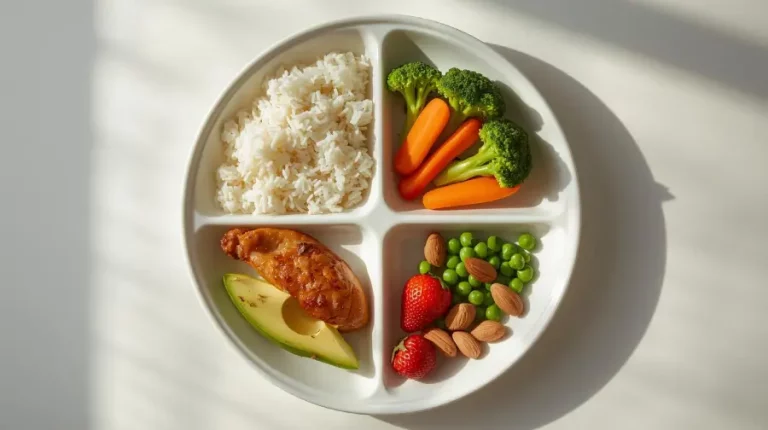5. Designing a Food Plan
In Overeaters Anonymous (OA), we strive to move from eating without awareness or structure toward mindful and orderly nourishment. In other words, we move from eating unplanned eating to planned eating. This simple shift represents an important aspect of our recovery program.
Eating with a plan goes beyond merely following a food schedule — yet the food plan itself is one of our most practical tools. It helps us find freedom from chaos, restore peace in our relationship with food, and experience the presence of our Higher Power in one of life’s simplest daily actions: eating.
The purpose of designing a food plan is not to create a rigid or restrictive diet, but to discover an approach that brings our body, mind, and spirit into harmony.
Each OA member, guided by personal experience, physical needs, and the guidance of their Higher Power, can develop a food plan that is both personal and sustainable.
The History of the Food Plan in OA
From the very beginning of Overeaters Anonymous (OA), the topic of the “food plan” has been one of the most discussed and debated subjects. From the early 1960s to the late 1980s, members, representatives, and the OA World Service Office made repeated efforts to strike a balance between offering practical guidance on food and preserving the program’s spiritual independence.
From Requests for Guidance to the First Published Plans (1961–1971)
At the 10th Annual OA National Conference in 1971, one of the most controversial questions was raised:
“Should the National Service Office prepare a set of suggested guidelines for eating? If so, what types of plans should be recommended?”
Many delegates — especially those from California — urged the publication of food guidelines to help newcomers know where to begin. Some even said:
“We don’t care what plan you suggest — just give us some guidance so we know what to tell the members!”
In response, the National Secretary of OA proposed that the central office publish two sample food plans, emphasizing that neither should be presented as “the only right way.” It was stressed that these plans were meant solely as physical guidance, not as a requirement for membership or recovery.
As a result, an eight-page booklet titled “Suggested Guidelines for Abstaining from Compulsive Overeating” was published.
The booklet included five definitions, twelve general guidelines, and two suggested food plans, both emphasizing three meals a day with no snacks in between.
The booklet clearly stated:
“There are no ‘hard and fast rules’ in OA. These food plans are offered only as suggestions to guide you on the physical level of this new way of life.”
The Formation of Plan A and Plan B
Midway through the booklet, two food plans were introduced:
Plan A – a low-carbohydrate plan for weight loss. It included a daily menu, a list of permitted foods, and practical recommendations for how to prepare and consume them.
Plan B – “The Four-Group Food Plan” — was developed in collaboration with a nutritionist named Marilyn Moore. This plan incorporated whole-grain bread, cooked potatoes, skim milk, and tomato juice to ensure a more balanced nutritional intake.
At the time, the goal was to give members the freedom to choose whichever plan best suited their personal needs.
However, differences began to arise when these plans were implemented at the local level. Some groups dropped one plan and distributed only the other— leading to growing disagreement within the fellowship.
From Enthusiasm to Differences of Opinion (1972–1976)
During the 1970s, some OA groups — particularly in California and New York — began to adopt stricter and more disciplined food structures. Groups such as the “Keepers of the Thin” and later “Westminster” promoted food plans that required complete abstinence from sugar and refined flour.
At the 1972 OA Conference, after long debates, delegates approved the publication of three food plans:
1. Plan A – a low-carbohydrate plan for weight loss
2. Plan B – the four- group food plan
3. A plan for maintaining a healthy weight
However, it was clearly emphasized that:
“OA does not endorse any specific food plan.”
Despite this, disagreements continued. Some members advocated for more structure and discipline, while others defended individual freedom and flexibility in food planning.
The Rise of the Westminster Movement
In the early 1970s, a group in Westminster, California, emerged with a highly structured and organized approach to the OA program.
This model quickly spread to New York, especially Long Island, leading to the formation of the “Westminster Long Island” group.
Members in this group completed daily written assignments on the first three Steps, and after thirty days, participated in a ceremony called “Step Up,” in which they were recognized as sponsors.
According to Phyllis, one of the members at that time:
“In our meetings, we talked about the Steps and true abstinence — not about slips. We felt we were strengthening OA, not breaking its Traditions.”
However, other OA groups believed that such a structured approach contradicted the fellowship’s spiritual principles and Traditions.
In time, Westminster evolved into an internal movement within OA, which later inspired offshoots known as “Poulos” and “Cambridge.”
The Blue Pamphlet and the Principle of Choice (1977–1987)
In 1977, the OA World Service Office released “A Suggested Abstinence Food Plan for Weight Loss”, which soon became known among members as the Blue Pamphlet.
This guide, prepared with the help of professional nutritionists, was intended to be a balanced and final version of earlier food plans.
However, just a year later, at the 1978 World Service Conference, representatives voted to publish another pamphlet titled “The Dignity of Choice.” This new publication presented eight different food plan options:
1. The Basic Four
2. Sugar and Flour-free
3. Vegetarian
4. Youth
5. Medical
6. Modified Carbohydrate
7. No Refined Carbohydrates
8. Maintenance
The intention was to offer greater freedom and flexibility to members.
In practice, though, it led to further debate about OA’s responsibility and boundaries regarding food guidance.
The 1987 Statement
Finally, after years of discussion and division, the 1987 World Service Conference approved a historic statement that shaped OA’s direction for the future:
“The publication or distribution of food plans in OA meetings constitutes a violation of Tradition Ten.
Each member is free to choose his or her own food plan,
but OA as a whole may not publish, endorse, or distribute any specific plan.
Nutrition is an outside issue, and employing professionals for that purpose conflicts with Tradition Eight.
Our focus is best kept on the Twelve Steps and Twelve Traditions — the true path to recovery.”
This statement marked a major turning point in OA’s history — shifting the program’s emphasis from external control of eating to spiritual recovery through the Steps.
From 1961 to 1987, the evolution of OA’s food plans was a journey of experimentation, conflict, growth, and maturity.
From the Yellow, Gray, Blue, and Orange pamphlets to “The Dignity of Choice”, members continually sought balance between the needs of the body and the call of the spirit.
In the end, OA learned that there is no single universal food plan — only individual paths of abstinence and recovery, discovered through guidance from a sponsor, professional advice when needed, and one’s Higher Power.
The First Step in Creating a Food Plan
To design a mindful and balanced food plan, we first need to develop a clear and responsible awareness of three key elements:
the kind of food we eat, the timing of our meals, and the quantity of food we consume.
Understanding these three aspects is the first step toward restoring balance and building a healthy relationship with food.
1. Type of Food
This aspect focuses on becoming familiar with the basic food groups: proteins, starches, fats, sugars, vegetables, and fruits.
Recognizing these categories helps us better understand our body’s needs and make conscious, informed choices about what we eat.
The goal is not to fear or eliminate any food group, but to learn how to include each one appropriately and in the right proportion.
Our bodies need all these groups for growth, repair, and normal functioning.
2. Timing of Meals
Awareness of when we eat is just as important as what we eat.
At this stage, it’s helpful to plan not only the meals and snacks we include in our food plan, but also the approximate times we intend to eat them throughout the day.
Keeping regular mealtimes helps us distinguish between physical hunger and emotional eating.
For many OA members, the basic guideline known as 3-0-1 — three moderate, nutritious meals a day and no snacks in between — serves as a foundation for order and peace of mind.
However, depending on individual health conditions or lifestyle, some members may choose to adjust the number of meals. What matters most is that the decision is made with awareness, honesty, and in consultation with a sponsor or qualified professional.
3. Quantity of Food
In this section, we become familiar with the concept of portions and measurement units.
Understanding appropriate quantities protects us from both overeating and undereating, helping us build a realistic and balanced relationship with our bodies.
For greater accuracy, using a scale or standard measuring cups is recommended — not for obsessive control, but as a practice of discipline and awareness.
General Guide to Food Measurements and Units
The measurements provided in OA food plans are meant as general guidelines. They may vary slightly depending on the type of food.
General Equivalents:
1 tablespoon = 3 teaspoons ≈ 30 grams
1 cup = 8 ounces ≈ 240 grams
1 ounce = 30 grams
Proteins:
30 g (1 oz) meat, poultry, or fish, 1 egg, 60 g (2 oz) cottage cheese or cooked beans, 30 g (1 oz) nuts or peanut butter
Starches and Grains:
1 slice whole-grain bread, 90 g (3 oz) cooked rice, barley, or corn, 120 g (4 oz) potato or starchy vegetable
Fruits:
1 medium fruit, 1 cup fresh fruit, ½ cup unsweetened frozen fruit
Vegetables:
1 cup raw vegetables, 2 cups cooked non-starchy vegetables
Milk and Substitutes:
1 cup low-fat milk or soy milk, 1 cup plain yogurt
Fats:
1 teaspoon oil or butter, 30 g (1 oz) avocado, 10–14 medium olives
Note on Food Labels:
We carefully read ingredient labels to ensure there are no trigger foods or hidden sugars.
Sugar can appear under various names such as sucrose, dextrose, fructose, or glucose.
Some members choose to eliminate all trigger foods, while others avoid only those ingredients listed among the first four on a product label.
Sample Food Plans in OA
In addition to the basic 3-0-1 plan (three moderate, balanced meals a day with no snacks), OA members around the world follow a variety of food patterns to bring order and peace to their eating.
These examples can serve as inspiration as you work with your sponsor and healthcare professional to design a plan that fits your own body, spirit, and daily needs.
There is no single plan for everyone. You may need adjustments for reasons such as vegetarianism, lactose intolerance, or specific health conditions.
In all cases, our goal is serenity, structure, and spiritual balance — not perfection or unnecessary rigidity.
Four Common Food Plan Patterns
1. The “Peaceful Balance” Plan
Features: Steady structure and balance among all food groups.
Best suited for: Newcomers, volume eaters, and weight-obsessed.
Spiritual focus: Moderation and respect for the body.
Suggested pattern:
Protein: 4 servings
Grains: 2
Fats: 2–3
Vegetables: 3–4
Fruits: 2–3
Milk or substitute: 1
2. The “Weight-loss” Plan
Features: Plenty of vegetables, lower fat, a feeling of lightness and cleansing.
Best suited for: Food addicts and bulimics.
Spiritual focus: Physical clarity and purification as a way to draw closer to a Higher Power.
Suggested pattern:
Protein: 2–3
Grains: 1–2
Fats: 2
Vegetables: 3
Fruits: 1–2
Milk or substitute: 1
3. “Balanced Energy” Plan
Features: To increase energy and physical strength through consuming healthy carbohydrates
Best suited for: Calorie restrictors and undereaters (anorexics).
Spiritual focus: Trusting the body and surrendering to life.
Suggested pattern:
Protein: 2
Grains: 2–3
Fats: 2
Vegetables: 2–3
Fruits: 1–2
Milk or substitute: 1
4. The “Strength and Focus” Plan
Features: Higher protein, lower sugar, and greater mental clarity.
Best suited for: Compulsive exercisers and fantasy eaters.
Spiritual focus: Experiencing inner strength and calm through structure.
Suggested balance:
Protein: 4
Grains: 1
Fats: 2
Vegetables: 4
Fruits: 1–2
Milk or substitute: 1
Conclusion
Creating a food plan in OA is not only about what we eat — it is about how we live: with awareness, honesty, and faith.
Each meal becomes an opportunity to practice presence, surrender to a Higher Power, and care for the body that allows us to serve life.
When we eat with love, order, and integrity, we gradually discover that food is not our enemy — it can be a sacred channel connecting us to God, to others, and to our truest selves.







